Here’s a detailed comparison of our two recumbent touring bicycles after riding them for over 10’000 kilometeres, including tips about how to choose the configuration when buying a recumbent.
We bought our recumbents in the spring of 2015. Miguel bought an Azub Six, Eva went for a Streetmachine Gte from HP Velotechnik. We chose these two different brands after trying and comparing different models in two different shops (one in Switzerland, one in France – for such expensive bikes it’s worth taking a few daytrips to different shops to be able to test-ride several models). One year later, we left on our trip which would take us from Switzerland to Portugal, and then across South America. After cycling over 10’000 kilometres, we reckoned that it would be a good time to review our bikes in detail and compare the two brands. We tried to include information that might be interesting for people thinking about buying a recumbent for travelling, as this was the kind of information we were trying to find at the time.
Disclaimer: This review represents our personal views and preferences, and our personal experiences when buying and using the bikes. There is no “absolute truth” when it comes to bicycle parts and bicycle travelling gear. In the end, everybody should make up their own mind about what they need and what they can afford. We use the terms “Azub” and “HPV” as an abbreviation for our models (i.e. Azub Six and HPV Streetmachine Gte).
If you don’t have time to read through the whole article, this is the bottom line: Both the Azub Six and the Streetmachine are very sturdy recumbent bicycles. After riding over 10’000 kilometres in varied terrains (and two long trips involving five different airplanes), we haven’t run into serious mechanical problems and both bikes still seem to be in great shape. Each has its advantages and drawbacks, but none is clearly “better”. We think that the Azub Six may be designed with more “serious” and heavy-loaded bicycle touring in mind. Meanwhile, we find that the Streetmachine has a very good finish with top-quality parts, and may be designed with the rider’s comfort in mind.
Buying the bicycles
Both Azub and HP Velotechnik have a website with detailed information about their models and with tips of how to choose the right recumbent. Both are also present on social media, and their websites include a list of people travelling with their recumbents. HPV will only deliver recumbents via a dealer, whereas Azub offers the possibility of direct purchase (although they strongly recommend buying through a dealer). On both websites, you can search for a dealer in your country, although both lists seem to be incomplete – our dealer does not show up on the Azub page, and the dealer in France where we went to test-ride both brands is not included in the HPV list (the same for two other dealers in Switzerland).
Let’s have a look at how you actually choose and configure your recumbent on each of the websites:
The Azub website includes articles about how to choose the components and information about each of the components. There’s even a specific article with their recommendations about the configuration of what they call an expedition bicycle. There’s also the possibility to ask questions in the Q&A section of each model (we didn’t use this feature). But if you want to see all the options and calculate the final price, you will need to download the PDF price list – there’s no automatic configurator, which is a pity, as the price list is a bit difficult to read (it’s a huge table, with one part specific to each model and a more general part at the end), and you have to calculate the final price yourself. Miguel ordered his bicycle by choosing the components on the list and giving it to our dealer in Switzerland, who then dealt directly with Azub. The delivery took one month longer than the expected six weeks because “the” Azub welder broke his leg. Azub quickly communicated about this, though.
The HPV website includes a recumbent FAQ, albeit only in German. There’s a description of every model, but not much in terms of how to choose the right configuration for you (they suggest contacting a dealer for this and for a test ride, which is probably sensible). The big advantage of the HPV site is the configuration tool, which presents all the available options for a given model and automatically calculates the price. The desired configuration can then be printed, or saved and accessed by the dealer later. The tool includes short descriptions of each optional part, but unfortunately lacks a few details that would be useful, such as the plateau and sprocket size used on the bicycle. The configurator has changed since Eva ordered her bicycle and has become much better (and less prone to crashing). Eva’s recumbent arrived at the dealer’s within the promised time frame, i.e. about 6 weeks after ordering.
Both websites have a lot of interesting information. The HPV configuration tool is very good and makes the ordering process very easy.
First impressions and first rides
The advantage of buying a touring bicycle several months before leaving for a trip is that we had time for several short and longer test rides, with and without our camping material. This proved to be invaluable: Although we were both happy with our bicycles and choices during the first rides, we then found a few details we were less happy about and wanted to change:
Miguel’s Azub:
- one brake arm (on the front brake) did not move freely,
- the chain guide was touching the front suspension (and thus rapidly showing signs of usage),
- and the screw for attaching the front light was too small for its function and needed to be replaced by a longer one.
In spite of these imperfections, we liked the fact that the Azub Six seemed to be built with the long-distance traveller in mind (e.g. a small front plateau and a sturdy kickstand capable of supporting the fully loaded bike).
Eva’s Streetmachine:
- both front breaks would not return as they should,
- the lowest gear was too high for comfortable uphill riding (tested on a ride up to the Furka pass in the Swiss Alps),
- and the centre kickstand was almost useless when the bicycle was loaded (more on this below).
In addition, it was tricky to find the right seat length and position with the BodyLink seat, and a bit more information about this would have been welcome in the manual or on the website. On the positive side, we liked the Streetmachine’s overall finish, with cables and chain guides well attached and the cables for the lighting system running nicely inside the frame.
Our first impression was that the HPV had a better finish but Azub was more cleverly built for touring.
A word on weight:
None of the websites includes reliable information on how much the bike is actually going to weigh. The weight of the Azub Six is described as “around 16 kg, according to the type” – Miguel’s bike ended up weighing around 20 kg. Similarly, the Streetmachine is described as “starting at 14,6 kg including pedals” – Eva’s Streetmachine also weighs around 20 kg.
Further observations during the trip
A few weeks into the trip, we realized that the HPV might have the two frame parts slightly misaligned, resulting in one side of the luggage rack touching the mudguard when the suspension is strongly used (such as when riding over speedbumps). By increasing the tension of the suspension, we found a way around the problem. But this lead us to realize that we would prefer a harder spring on the rear suspension, which is not available in the configurator (the Azub standard is 750lbs/inch whereas HPV’s strongest is 550lbs/inch, although they have harder springs on offer in their spare parts catalogue).
On the side of the Azub, the handlebar has rusted in several places, which we find a bit strange. Miguel contacted Azub but they consider it normal and suggest simply repainting it.
So, let’s go and compare these two recumbent bicycles in detail! You can find the complete setup of our recumbents in table format here.
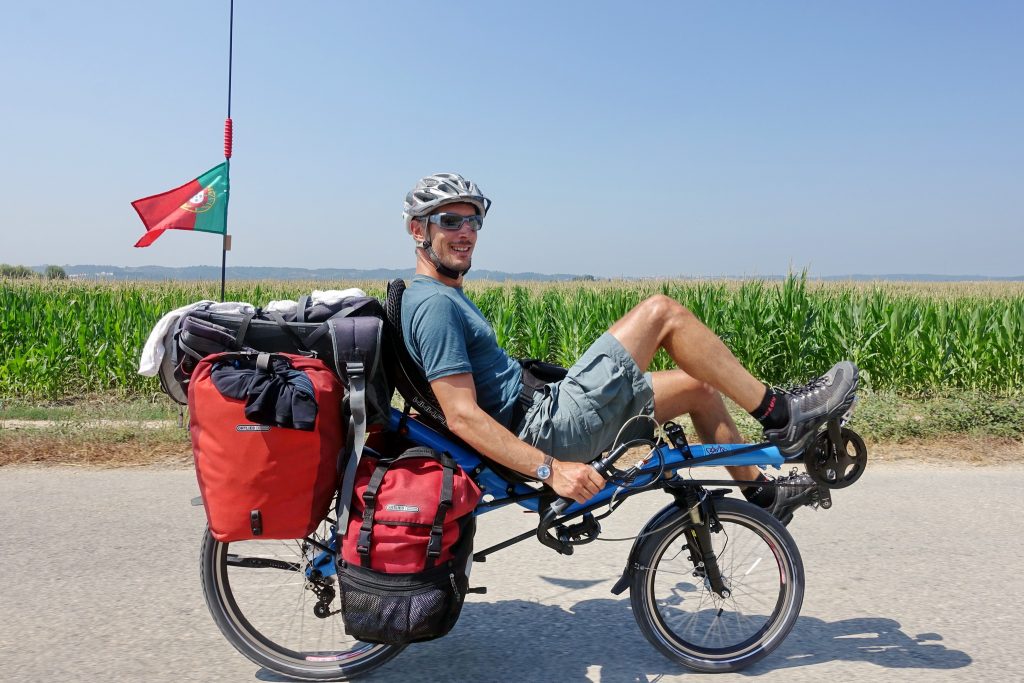
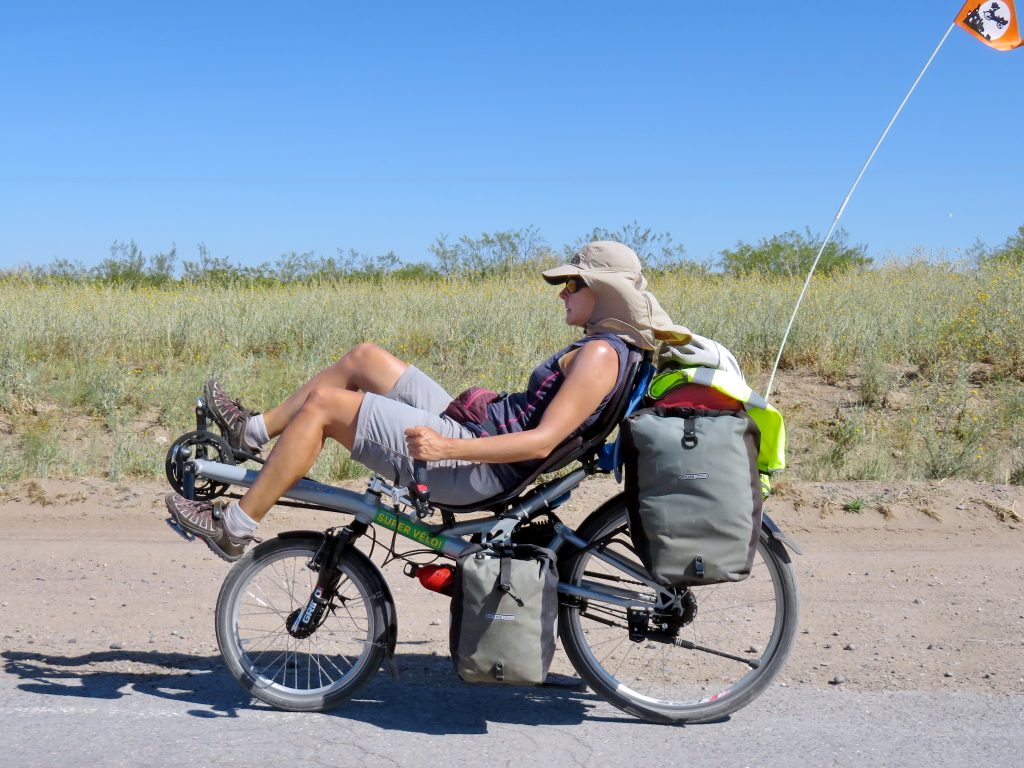
Colour
Both HPV and Azub offer a set of standard colours (two colours for HPV, eight for Azub), in addition to a large palette of custom colours at an additional price. We both chose a standard colour (silver grey for the Streetmachine, blue for the Azub Six).
We personally think that other items are more important than colour, but if a nice-looking bike is important to you, Azub offers more customization options (including colours on non-frame parts, such as the luggage rack).
Seat
We took some time adjusting to the recumbent position and figuring out the right inclination and seat position, which is normal as this riding position is so different from what we are used to. In the end, we both found a position we like and are both happy with our seats. There are nevertheless a few differences between the two models:
Azub offers three seat sizes (M, L and XL). It is very easy to change position: Through quick releases, the seat can slide forwards and backwards, and another quick release change the seat inclination (i.e. seated versus more recumbent position). The positioning system allows for quite an upright seat position, with a large range of inclination. The seat position is very easy to change on the go, although the screw adjusting the forward-backward movement can be difficult to tighten enough and the seat would sometimes move backwards. Miguel (whose height is 175 cm) got the standard size M seat with the Ventisit pad. The mesh of the seat pad does not get soaked in the rain, which is a plus. The edge of the seat is quite sharp, which is uncomfortable when pushing the bike.
Eva chose the BodyLink seat for the HPV. This seat is composed of two parts, so the seat length can be adjusted. Finding the right length took quite some time, and adjustments were necessary while riding during the first few months – it is a good idea to always carry an Allen key during rides, especially at the beginning. The seat position can be adapted with quick release screws on the back (seated vs recumbent position) and front (to lower or lift the seat rim, which also changes the lumbar curve of the seat). The most “seated” position is already very recumbent when compared to the Azub. We find it a bit too recumbent for a touring bicycle, because the focus is on comfort and not speed, and at a certain point it becomes difficult to hold the head upright. Thus, most of the time Eva rides with the seat in the most upright position. The BodyLink seat has an annoying tendency to creak – although if you tighten the middle quick release as much as possible it at least partially solves the problem. The edges of the seat are nicely rounded (more comfortable for pushing) and are reflective in the dark. Eva chose the airflow pad (as opposed to the standard foam pad), which is comfortable and removable (and even washable), but it gets soaking wet in the rain and takes several hours to dry. The optional rain cover is therefore essential if you have to leave the bike out in the rain (it’s completely waterproof and we’ve also used it at times for packing the tent). Eva didn’t find the headrest useful, it was uncomfortable with a helmet. Eva left it behind after 4000km travelling (on a side note, it was useful to attach the water bag to the back of the seat…).
Azub has the advantage of a larger range of positions and the fast-drying mesh seat pad, and HPV has the advantage of the adjustable seat length.
Extra thought: It would be great to have a grip on the upper back of the seat to push the bikes. None of the brands provides that, and recumbents are notoriously uncomfortable to push…
Brake system
We both chose V-brakes, as they are easier to maintain on the road, and replacement parts probably easier to find. Azub came with Tektro and sturdy Jagwire moutain pro cables and HPV with Avid single-digit on standard cables, fit with SnakeSeal cable protection.
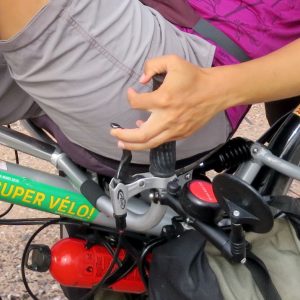
The HPV break levers are mounted “upside down”, so you mainly use the 3rd to 5th fingers for breaking. It’s not ideal for people with small hands, but the advantage is that the cable routing is more direct with less bends, and HPV (probably deliberately) chose a model made for single-digit use. The SnakeSeal prevents water from getting into the brake cables. It is made up of two rubber parts, which came apart a few times and were very fiddly to get back together (the instructions are downloadable from the HPV website and very useful to understand how the system works).
Both of us had problems with the breaks soon after delivery. One of Azub’s brake arms was not moving freely, and HPV’s brake levers were not returning well. We (and two bike mechanics in Switzerland) had a go at finding a solution to the problem, but it was only fully fixed by our mechanic in Lisbon, who dismounted the break arms completely. The problem was due to some oxidation in the interior of the brake arms! It was probably a coincidence that we both had the same issue on different brands… After this fix, the brakes on both our bikes worked fine for the whole journey across South America.
We don’t have much to say about the V-brakes, except that we expected better-quality standard brakes on the Azub, especially in the combination with the Rohloff (Shimano XT is available at an extra cost). For a travelling bike, break shoes with removable pads would be a plus (smaller spare part to carry).
Handlebars and cable routing
We chose under the seat steering (USS) for both our bicycles. After trying different types of steering, we found USS the most comfortable, with a very natural and relaxed seat position. This is very personal though, so trying different steering positions before buying is a good idea.
The HPV’s handlebar is 60cm wide and the Azub’s is 5cm wider. We did not encounter any problems due to this difference (i.e. getting into doors or trains).
Azub has indirect steering, which allows to choose between 3 different turning radii (default is the small=quicker turns). This is useful for parking and when needing to turn around. The handlebar is positioned below the frame and has a security system that allows it to rotate when the bicycle falls, to avoid damage. It works (read – it rotates), but did not avoid scratches and rust on the bends of the handlebar. The cables are routed upwards and bend back downwards towards the breaks and the gear system, all through an Azub-specific system.
HPV has direct steering and a larger turning radius (i.e. it’s more difficult to turn around and go around obstacles, as the handlebar starts touching the seat at a certain point). The handlebar is positioned below the seat and above the frame. The cables are routed downwards from the handles, then cross over towards the back and front wheels.
The arm and hand positions are different between the two models (hands lower and arms stretched out more on the Azub, hands more vertical and elbows bent more on the HPV, see pictures above) and should be chosen according to personal preferences.
There is rust on the Azub handlebar (not only due to falls!) after less than one year travelling, thus there must be some difference in quality of the material between the two brands.
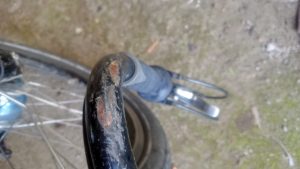
Although there are quite a few differences between the two brands, both handlebars allow for a comfortable position. The main advantage of the Azub model is the smaller turning radius, whereas the HPV model uses a simpler cable (gear and brake) routing.
Tires
Eva’s HPV has Schwalbe Marathon Plus on both wheels. Miguel’s Azub has Schwalbe Marathon Plus in the front and Schwalbe Marathon Mondial on the rear wheel. We found both models to be very sturdy and resistant – Eva’s rear tire got punctured for the first time after 9000 km travelling (and about 10’000 km total riding distance since buying the bike), and we replaced the tire. Miguel is still continuing with his original tire. On both bikes, the front tires don’t show a lot of signs of usage yet.
It is a nice touch from Azub to allow to choose between two different tire models for the rear wheel, but we don’t know if this really makes a big difference.
Wheels
The bicycles differ on the wheel setup: Azub went for the Czech brand Remerx (model Country Ring), with 36 spokes and Schrader valve. HPV chose Alexrims (model DA16) with 32 spokes and Presta valve. In 10’000 km of travelling (mostly on asphalt), we didn’t have any problems with the rims or spokes. We just noticed that the Azub’s nipples got deformed when tuning the wheel and needed to be replaced (low quality nipples, according to our bike mechanic). In South America, almost all bicycles have Schrader valves, and it is therefore much easier to pump up the tires in bike shops or fuel stations.
While HPV has seemingly better quality material, Azub has the Schrader valve which is much more useful for travelling.
Gear system
We both splurged on a Rohloff hub (black on the HPV and silver on the Azub – Azub allows choosing the colour of the Rohloff hub). The hubs were installed with the standard 16 tooth sprocket and there were no options to choose a different size. We both ended up changing the sprocket to a bigger one (18 or 19 tooth) to make better use of the whole range of gears and to make climbing easier. We think that the Rohloff speed hub is probably one of the most useful investments for a touring bicycle. For us, it worked (and still works) extremely well, never broke down, and needs almost no maintenance. The fact that you can change several gears at a time, and change gears without pedalling, is very useful, especially for recumbents. If you have ever stopped at a red light and forgotten to gear down, and then tried to start in a high gear on a loaded recumbent, you know what we’re talking about…
The main difference between our bikes lies in the gear shifters:
Azub has the standard Rohloff twist-shifter, whereas HPV has the long Rohloff barend specially developed for recumbents and other special bikes. Both are installed on the right side. The long twist-shifter on the HPV is much easier to turn with wet or sweaty hands and is very useful especially for people with smaller (and not very strong) hands. When we came back from South America, after about 9000 km travelling, Miguel could barely turn his standard shifter anymore and had to buy bike gloves to be able to change his gears. It was due to the brake cables getting signs of usage, and the problem resolved with new cables.
We love our Rohloff hubs. We also think that the long Rohloff twist shifter on the HPV is a great piece of gear (we just wish they wouldn’t sell it so expensively as a spare part…).
Crankset and pedals
One of the main differences between Azub and HPV is the choice of the crankset and chain ring size in combination with the Rohloff hub.
The Azub is fitted with a Shimano Alfine crankset with integrated axle and bottom bracket cups (looks nice and avoids dirt), with a 39-tooth chain ring configuration. The chain guard is metal on the outer side and plastic on the interior, and although it looks more fragile than the HPV version, it has in reality been very sturdy.
HPV decided for a Sugino crankset with the option of short (155 mm) or standard (170 mm) cranks. Eva chose the 155 mm version, which is recommended for smaller people (i.e. below 175 cm), and finds it very comfortable to ride (the amplitude of the knee movements is smaller). The chain guard is metal on both sides, it seems of better quality than Azub’s (however it bends quite easily, as we observed after flying with the bikes). The HPV StreetMachine comes with a 46-tooth chain ring in combination with the 16-tooth Rohloff sprocket. It was clear for Eva after just a few rides that this is not an optimal configuration for a travelling bike. The lowest gear was clearly not low enough to go uphill comfortably, whereas the higher gears (from 10 upwards) were almost never used (who would pedal downhill?), so she changed to a 38-tooth chain ring (leaving the bigger chain guard, which actually nicely protects the front light).
Both brands offer the option to have clipless pedals (which are almost essential on recumbents). At the time, HPV offered the option of Shimano PD-A530, which are lighter but more expensive than the Azub’s Shimano PDM-324. We each like our pedals and don’t have a preference towards one or the other (the PD-A530 are a bit harder t to get in and out, which is only an issue while getting used to it).
In our opinion, 39-tooth is the maximum size for a touring chain ring with the Rohloff hub on a 26-inch wheel. We cannot understand why HPV does not give an option to configure any size smaller than a 46-tooth (especially as they do have a 39-tooth option in their spare parts list). After 10’000km on a recumbent with Rohloff, Miguel’s preference goes for a 36-tooth chain ring and a 16-tooth standard sprocket (he has now a 39t chain ring with 18t sprocket which is a similar configuration).
Lighting system and dynamo
Both brands offer a range of options of lighting systems and dynamos (versus battery powered lights). Miguel ordered his Azub with a SON dynamo hub and installed lighting wires (without the lighting set, which he installed by himself). Eva got her HPV with a SRAM D7 dynamo hub (not produced any more) and B&M lighting system (IQ-fly LED lamps included).
The HPV wires are nicely routed inside the frame for both front and rear lights and dynamo. Azub had the wire nicely routed between the lights but not so nice for going down the fork to the hub, which Miguel had to redo. The electrical cable was coaxial, less practical for wiring than a double cable. The screw to fix the light on the Azub was also too small and missing a couple of washers to be ready for use. Other than that, our lights worked well most of the time and were very useful not only in the dark, but also to be seen in daylight. Until now, we haven’t used the hub dynamos for charging electrical devices, but we might do so in the future.
All in all, we’re happy with our hub dynamo lighting systems, and we don’t have a preference for one or the other option.
Rear suspension
We noticed the importance of the rear suspension when cycling on bumpy, unasphalted roads, alongside other touring cyclists on non-suspended, standard bicycles. We were much more comfortable and able to ride faster than them! Both bikes have DNV DV-22 rear suspensions, which are relatively simple spring suspensions, which we preferred for travelling over the more complicated models. However, Azub comes with a hefty 750 lbs/inch spring, whereas HPV (on its strongest choice, i.e. 100-130 kg total charge) comes with a 550 lbs/inch spring. From the beginning of our trip, Eva found the HPV spring too soft for a charged bike (total charge about 100 kg). The mudguard would touch the luggage rack when cycling over bumps (such as standard speed bumps), which did some superficial damage to the rack (due to the mudguard’s screw). Thus we had to turn the spring quite a lot to make it hard enough (which now makes the riding a little bit less comfortable). HPV has the option to have harder springs in their spare parts catalogue, again it’s a pity they don’t offer all their options in the configurator.
We think that the Azub’s harder spring is more appropriate for fully loaded bikes.
Here’s a nice demonstration of how hard the suspension has to work on a bumpy road:
Front suspension
Before buying the bikes, we had been able to compare a recumbent with and one without the front suspension, and we confirm that with a 20-inch front wheel it does make a noticeable difference when cycling over bumps and uneven terrain. Miguel chose to have a better and lighter front suspension on the Azub (Meks carbon), with adjustable damping. Eva chose the standard Spinner Grind 2 on the HPV. We are both happy with the suspension, but Miguel would have liked Azub to pay more attention to the mounting (the suspension screw touches and damages the chain guide).
In our view the front suspension is a must for 20-inch wheels, but we’re not sure whether Miguel’s more expensive option makes a significant difference in comfort. Both suspensions still work well after 10’000 km.
Kickstand
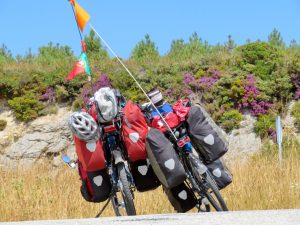
The main issue with the kickstand is that it has to be able to hold a heavily loaded bicycle. The Azub comes with a Pletscher Comp Zoom rear kickstand, which holds the bike well, even when fully charged. At the time when Eva bought her HPV Streetmachine, the only option (when choosing a lowrider rack) was a short Pletscher center kickstand mounted on the lowrider (now there’s also the Comp Zoom as an option). The centre kickstand is useless at best, and even dangerous at times (the loaded bike tends to pivot around the kickstand and to fall on its left side – it once fell on Eva’s leg fully loaded). Eva tried another rear kickstand for some time (Ergotec), but it was not strong enough, so she will now mount a Pletscher Comp Zoom, too.
The Pletscher Comp Zoom rear kickstand seems to be the only one capable of safely holding a loaded recumbent.
Luggage racks
Both brands offer the possibility of having a smaller or larger luggage rack, depending on the number of panniers they can hold. Miguel chose the Expedition carrier for his Azub. It is made of aluminium welded to the frame (rear boom) and takes two pairs of panniers (Azub has the option of the Super Expedition carrier on above-seat-steering bikes which takes three pairs). The weight of the panniers is mostly on the rear part of the bike (see pictures above).
Eva chose HPV’s rear rack and the low-rider, which are attached with screws onto the frame and have space for two pairs of panniers. The lowrider is placed low between the wheels, making it an ideal place for heavy stuff as this actually stabilizes the bike. As a downside, the panniers placed on the lowrider are quite close to the ground and are thus the first thing to touch the ground in case of a fall (our small Ortlieb panniers got a couple of holes because of this).
Both racks seem strong enough for extended travels and didn’t get any damage, apart from the older Ortlieb panniers rubbing away the paint in several spots.
Mudgards, mirror, flag, bell
We chose back and front SKS mudguards for both bikes. Not the exact same model, but both are doing their job well.
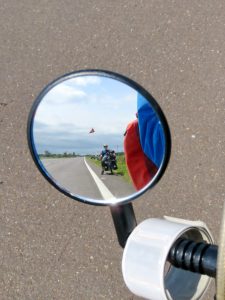
Also, both bicycles have a very good Mirrycle mirror, the most important safety feature on any touring bicycle (especially recumbents) – we rate it more important than a helmet! Azub has it mounted directly on the end of the left handlebar, while HPV has it mounted to the handlebar via a bar-end mounting. Both solutions are good, give enough visibility, and the mirrors can be folded away when transporting the bike. The only thing we haven’t figured out yet is how we’re going to change the mirror to the right side on the day we want to go cycling to a country with left-sided traffic, as the Rohloff cables and twist-shifter are on the right…
We both use a long flag for visibility. The Azub security flag is not very flexible, and the middle piece broke quickly on one of the first weekend rides when the upper part got caught in a tree. HPV makes the Moonbiker flag, which came in two pieces in its old version (which Eva still uses). Miguel bought a new version of the Moonbiker flag which is a single piece, but folds in the middle (great for storage or when entering a building or train with the bike). It’s a good flag with enough flexibility, it has survived strong winds and getting caught in all kinds of things without major damage.
The HPV came with a bell installed (although just a very basic one, which Eva replaced). The Azub didn’t have a bell. The bell should be, in our opinion, part of any bicycle.
Other points
The Azub’s rear boom and luggage rack are aligned with the wheel, so the bicycle can stand upright without support, which is useful when keeping the bicycle inside or when there is limited space.
Miguel got the optional bike computer holder on the Azub (there is also this option for the HPV). It is practical when you have USS, as you can’t use the handlebar for accessories.
Documentation
Miguel’s Azub came with written documentation which we think was below the quality you would expect for the price of the bicycle: a basic manual, printed in black and white, intended for an older version of the bicycle and with several English grammar and spelling errors. Since May 2016, there is a new manual available online, which is much better and has a more professional look, but it still misses some proofreading.
Eva’s HPV came with a professional and reasonably complete manual, to be chosen either in German or English.
We would have liked a complete list of the parts (brands, sizes) used on the bikes, such as the brand/model of the chain, the length of the spokes, etc, which would have been useful information when buying spare parts.
Packing for flying
It is easier to pack the Azub than the HPV. On the Azub, after removing the seat, you only need to remove four screws to turn the handlebar. On the HPV you need to completely remove the handlebar, thus requiring attaching the front fork to the frame with zip ties. Both the handlebar A-head and the back of the seat are greased, so the mounting and dismounting are a bit messy. When refitting the handlebar it is necessary to re-align the wheel and adjust the A-head, which is not a big deal but takes some time. On the other hand, the dismountable seat on the HPV is more practical to pack.
Customer service
Miguel contacted Azub by E-mail twice for technical questions, and it took more than a week to get an answer. We found that the answers could have been more complete, clear and customer oriented (e.g. when Miguel asked about the brand and model of the chain, he didn’t get a complete answer). On their website, they have an FAQ section (with very few questions), and a “Question and Answer” feature for each specific model, which doesn’t seem used very often either. Azub also has a Facebook page, where they mostly share Azub-related things from other pages (blogs, photos, etc.) and some news from their company.
Although HPV seems to prefer people getting in touch with a dealer first, they were happy to reply to the e-mails Eva sent them with different questions. They seem to have dedicated customer relations personnel that handle E-mails fast. Eva had to insist a bit a couple of times to get a satisfying answer (as for example with the issue of the frame asymmetry), but always ended up getting useful answers. They also manifested their interest in our trip and offered on-the-road support for any mechanical questions (we didn’t need it in the end, but it was a really nice gesture). They also have a Facebook page, where they share new developments and interesting stuff from other pages, plus two Facebook groups, moderated by an HPV collaborator, where people can ask questions and share experiences. Plus, once you own one of their bikes you can order every imaginable spare part directly from them (without going through your dealer), they have an exhaustive price list online.
Through the few direct interactions we had, we felt that HPV has a more professional customer relations service. In addition, they seemed to be very eager to get to know and follow people travelling on their recumbents, which gives a more personal feel.
Conclusion
Both recumbents are really good and we’re very happy we bought them. There’s no “winner” – they are mostly the same, a bit different on a few aspects, but most differences don’t really play such a big role. It’s mostly a question of personal preferences – the overall shape, the seating position, the handlebar. We don’t have a preference for one brand or the other and would buy the same recumbents again, although we would pay more attention to be able to customize them from the start.
What tips would we give to the manufacturers? We feel strongly that when buying such an expensive bike (we paid over 4000 EUR each), we should be allowed to expect high-quality components, a good finish, good quality documentation and professional customer support (this is for Azub). A larger variety of customizable options would be appreciated to be able to get a recumbent that is truly ready for heavy-duty travelling (this one is for HPV).
“So, how do I decide which recumbent to buy?”
… you’re asking. We say, buy one or the other, it doesn’t really make that big of a difference. Choose the model that is closest to what is important for you, as long as you keep in mind the following points:
- Go and visit different dealers to try as many models as you can. Try USS, ASS, different seats. Some big international bike fairs (such as Eurobike) may also be a good occasion. Take your time to make your choice. Some shops even agree to rent a recumbent for a day or weekend.
- Try to find a dealer who agrees to customize your recumbent exactly the way you want it. This will save you time and money later, when you won’t have to take it back to the shop and purchase new parts because you’re not satisfied.
One more point: Size matters. Eva is 166 cm tall and she can just about touch the floor with the point of her foot when sitting on the recumbent. If you’re smaller, you’d better investigate into getting something with a lower seat or with two 20-inch wheels.
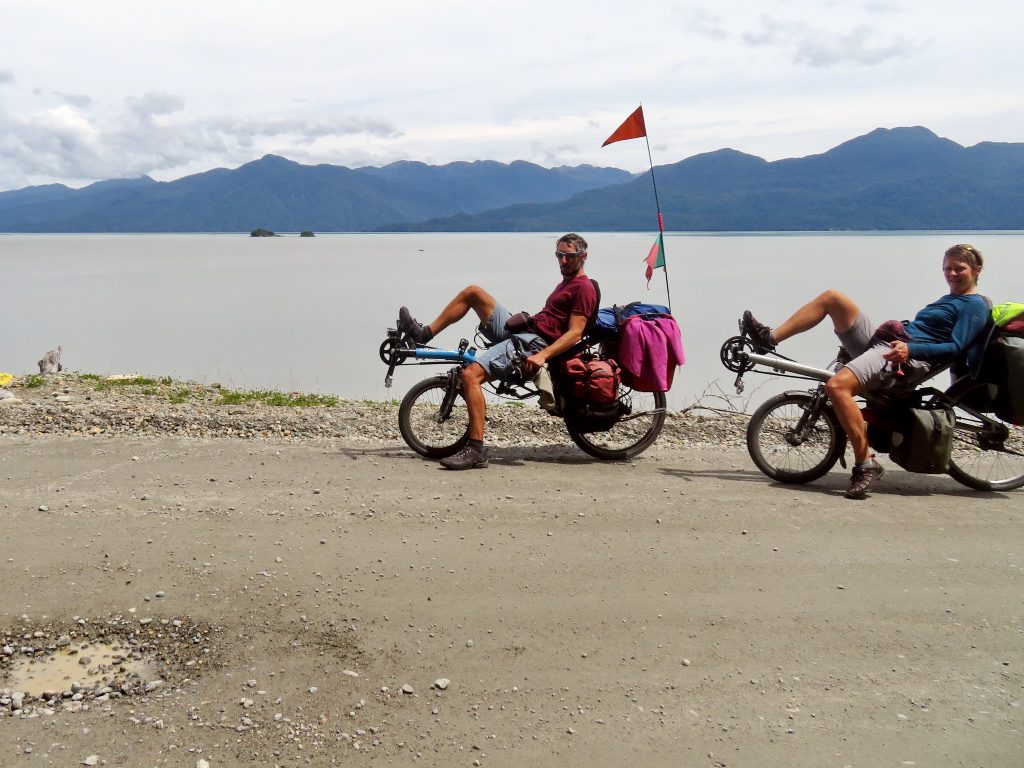






















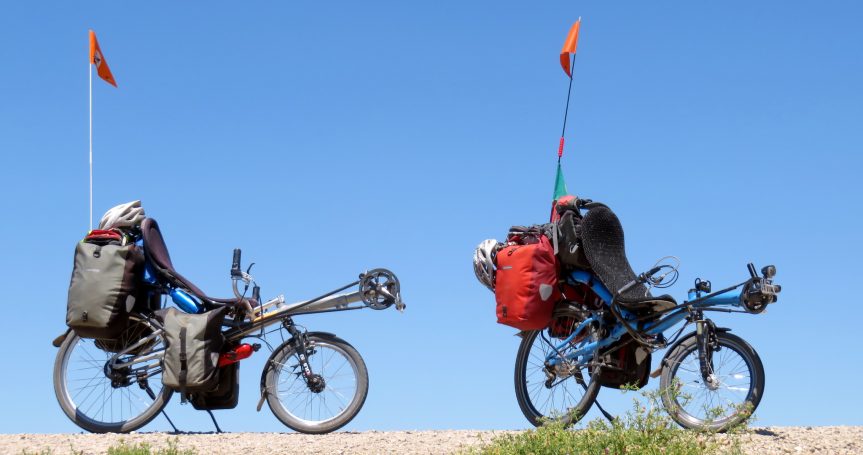
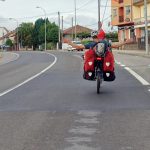

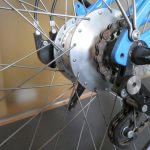
Thank-you for the review. On the Azub did you notice lateral flex in the seat? I had a mesh seat and the wider seat had considerable flex, I also had the seat slip. The HP mounting is much more robust although it does not have the same degree of adjustability. I also felt the bolts used on the Azub were not as robust as those on the HPV. I found your comments on brakes very interesting,
my choice was disks with ~35Kg of panniers. You indicated no issues with stopping power.
Thanks again for the review, most interesting, ted
Hi Ted, thanks for your comment.
I did not notice any lateral flex on the Azub seat, it seems to me quite rigid and sturdy. The fact that it might slip backwards is a trade off of having the possibility to move the seat to a more or less recumbent position, which I found quite nice. After closing the lower quick-release as strong as I could, then it did not move anymore.
Concerning the breaks, we did not had any issues on the Azub or HPV with the stopping power using v-brakes. Maybe we could have the bicycles to stop quicker when breaking from 60+ km/h to 0, but we only tried those speeds on very safe situations. During a normal ride and even steep downhills (I just remember the paso Carirriñe into Chile) we did not have any problems breaking.
Cheers,
Miguel Anjo
Hi Miguel, thanks for the interesting review! I tried both models and finally chose the Azub because of the more upright seat position. After 3 years I’m still very happy with my choice and never had any technical problems.
For the Azub I would add, that it is very easy to push the bike with the optional head rest attached. This way I can manouvre the bike with one hand even through crowds of people with just small tilting movements.
Best regards
Stefan
Hi Stefan,
Thanks for your comment. Can you tell me if riding your the Azub with helmet is confortable, even with the head rest?
I don’t have a headrest on mine.
Cheers,
Miguel Anjo
Hi Stephan
Can you explain a bit more please why you preferred the more upright seating position of the Azub? How big a difference is there/ I’m deciding myself between the two models, so it would be useful to have a better idea of your decision process. Many thanks, Andrew
Hi Stefan
I was interested in your choice of the Azub because of the more upright seating position. Can you say any more about that? It sounds like there was a noticeable difference. What was it about the more upright position that you preferred? My address: andrewopie6@gmail.com. Best regards
Andrew
Hi Miguel, I have no problems with the headrest when wearing a helmet. It’s adjustable in height, so you can make it lower if it touches your helmet. I’m really glad I have it attached, otherwise pushing the bike would be difficult.
At the moment I’m riding with a rigid front fork. I was wondering if I should get the Meks Carbon fork, but it doesn’t seem to be available anymore for V-brakes (new model is disc-brakes only). It was interesting to read that the spinner fork is equally good. It seems to be the only option for V-brakes now.
Very interesting tour, I will follow your blog now 🙂
Best regards,
Stefan
Bonjour
I was an Azub owner when my wife choosed to get a recumbent also, so she tried both mine and an HPV. She liked more the seat but chooses the Azub because the luggage rack is higher, so we can carry 4 large Ortlieb panniers.
We travel with our 2 Azub Six since 3 years, only a problem with a shock absorber, well solved by the manufacturer (Suntour), it was fully free even if the warranty expired since a long time.
About the kickstand, we use some Hebbie, very strong.
And to push the bikes (because we are now in New Zealand and often have to push) we no longer stay on the side : We push by the rear, both hands on the Rack Pack, it’s much easier and better for our back.
Enjoy your trip !
Hi guys, I’ve just purchased a 2º hand HP streetmachine ( like new ! ) it has disc brakes which I don’t like but they work very good. the only think I’ve noticed is the lack of “small gears” I mean for uphill motion. I hope I’d de able to change for something better. good to know that the small kickstand on the low rider is not good enough. on the rear is fitted with the dual drive , front chain wheel with 39 T ??? I’ll see if is going to be enough for climbing. anyhow thank you so much for sharing your experiences. good luck and happy and safe travels. Tony from Trieste.
Hi Tony,
Thanks for your comment! We’re just back from a small tour around the Austrian-Italian Alps.
Enjoy your rides!
Eva
Hello Eva and Miguel,
Thanks for such a great review article. I recently bought a second-hand HPV SMGTe and love it. For now, I’m just using it as a casual bike as I get into shape but I chose it because I hope to begin touring.
Eva, you and I are the same height. Mine came with the standard pedal cranks and I’ve been thinking of switching to the 155 cranks. I’ve been struggling with knee pain and hope that the 155 cranks might help. However, I was surprised to see that you found the HPV to need lower gears than standard and wonder if the 155 cranks might have anything to do with that. Though I haven’t been riding with a load, I have been climbing ever steeper hills, some very steep (feel like I’m almost upside down), and, so far, I haven’t found that it needs a lower gear. I suspect that this is either because I’m riding without a load or wonder if it could be the smaller circle (less leverage) of the 155 on you end. Your thoughts on this issue?
In the meantime, I’ve strapped hard-soled sandals to the bottom of my shoes and find that I can reach the ground and the pedals a little easier. 🙂
Your article was very encouraging to me as I begin to prepare to tour. Thank you to both of you.
Wayne
Santa Fe, NM
Eva and Miguel,
In my first message, I forgot to ask Eva if she has purchased parts from HP since the original purchase. My second-hand HPV SMGTe came without fenders (mudguards?) and with the standard 170 or 175 pedal cranks. I would like to add fenders and switch to the 155 pedal cranks, and buy the seat attachment for shorter riders (I’m the same height as Eva). Have you purchased anything from HP after the original purchase? How did it go? Were they able to ship directly to you?
Thanks,
Wayne
Sorry, I see the answers to this question at the end of the article. I started skimming toward the end. Thanks again,
Wayne
Eva,
Which SKS mudguard did you order, front and back?
Thanks,
Wayne
Hi Wayne,
Thanks for your comments and sorry for not replying sooner – we were out for a small autumn tour in the Alps 🙂
Now concerning your questions:
155 cranks: I’m very happy with them but I have no idea whether they contribute to the “gear not low enough” feeling, as they have been the only ones I ever had on my recumbent.
Low gears: As you probably noticed, we both have Rohloff gear hubs. So the part about low gears not being low enough only applies to this setup. It can be completely different if you have a different gear system and we can’t give our advice about that, as we only ever had a Rohloff on our recumbents. Plus, I guess this is also a bit of a personal preference question. I just found it easier to be able to pedal in higher frequencies rather than push hard on the pedals. The downside is that I sometimes miss a higher gear, but it’s only very occasional. With my current setup, I use the whole 14-gear-range of the Rohloff, whereas before I would use the higher gears very rarely.
I haven’t purchased anything directly from HPV since I bought the bike, but have been in touch with them otherwise and they’ve always been very helpful. Although they don’t sell recumbents directly (only via dealer), they do sell spare parts directly if you already own one of their recumbents. They have a complete spare parts list on their site with prices. Don’t hesitate to drop them an e-mail if you’re not sure about which parts to order.
Mudgards: I just got the ones proposed by HPV, I don’t know which model it is. But from what I can see from the SKS website, they look like their Bluemels model.
I hope this helps a bit, and enjoy your rides with your Streetmachine!
Best, Eva
Eva, thanks for your detailed response, it is very helpful. I look forward to your next article and photos. I’ve enjoyed your site and stories.
Wayne
Hi Eva and Miguel,
Eva, were you able to reach the ground from the Azub seat or is it the same height as the HPV?
Thanks,
Wayne
Hi Wayne,
I can reach the ground from the Azub seat, although it’s a little bit higher than on the Streetmachine. It’s maybe 1 cm higher or so.
Hope that helps
Eva
Hello
With the smaller front wheel is it easier starting off from a dead stop? Even on a slight hill?
I had a “high wheeler” (26″ wheels front & back) and found it to be very difficult to start off.
Thanks
Don
Hi Don,
Before buying our bicycles, we tried the Azub Max, with two 26″ wheels, and we find as difficult to start as with the Azub Six (20″ in the front). But we believe that was mostly because of lack of practice at the time.
We think the most important is being able to stop quickly without losing balance and for that you should be able to have the two foot (at least the toes) on the floor when stopped. Then starting off is a matter of practice.
Cheers,
Miguel & Eva
If you discarded your packing material on arrival to your destination how do you find packing material in unfamiliar countries to repack bikes at your return trip home, I assume it to be too bulky to travel with it and reuse it, thanks
Hi Frank, we use basic packing material such as bubble wrap and tape, which we found easily in DIY stores in Portugal and Chile (the only 2 countries we flew from with our bikes).
Hi Miguel, thanks for the interesting and detailed review!
The review inspire me and waiting for the post corrona period and consider a long trip but meanwhile considering long trip in my country Israel as well.
i’m considering to purchase the AZUB six and really appreciate if you will be able to provide more details based on your experience on the following issue:
I’m leaving nearby Jerusalem in hilly area and would like to get some information about climbing with the Azub six,are they easy climbers ? are they usually stable in low speeds and all other aspects regarding climbing. Thx a lot Doron